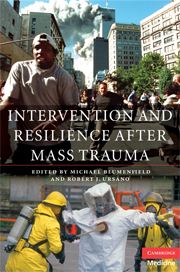Book contents
- Frontmatter
- Contents
- List of contributors
- Foreword by Joseph T. English
- Preface
- 1 Systems, science, and populations: Effective early mental health intervention following mass trauma: the roles of government, clinicians, and communities
- 2 Factors in the development of community resilience to disasters
- 3 Psychological first aid
- 4 Acute stress disorder and early interventions after trauma
- 5 The role of pharmacotherapy in early interventions
- 6 Should culture considerations influence early intervention?
- 7 Resilience is the default: how not to miss it
- 8 Epilog: Early intervention for individuals and communities: planning for the future while meeting present needs
- Index
- References
4 - Acute stress disorder and early interventions after trauma
- Frontmatter
- Contents
- List of contributors
- Foreword by Joseph T. English
- Preface
- 1 Systems, science, and populations: Effective early mental health intervention following mass trauma: the roles of government, clinicians, and communities
- 2 Factors in the development of community resilience to disasters
- 3 Psychological first aid
- 4 Acute stress disorder and early interventions after trauma
- 5 The role of pharmacotherapy in early interventions
- 6 Should culture considerations influence early intervention?
- 7 Resilience is the default: how not to miss it
- 8 Epilog: Early intervention for individuals and communities: planning for the future while meeting present needs
- Index
- References
Summary
Who should we treat with early intervention?
The possibility of early intervention after trauma exposure presumes that people exposed to trauma are high risk for developing a psychiatric disorder. There are reports of high rates of emotional numbing (Feinstein, 1989; Noyes et al., 1977), reduced awareness of one's environment (Berah et al., 1984; Hillman, 1981), derealization (Cardeña and Spiegel, 1993; Freinkel et al., 1994; Noyes and Kletti, 1977; Sloan, 1988), depersonalization (Cardeña and Spiegel, 1993; Freinkel et al., 1994; Noyes et al., 1977; Sloan, 1988) dissociative amnesia (Cardeña and Spiegel, 1993; Feinstein, 1989; Madakasira and O'Brien, 1987), intrusive thoughts (Cardeña and Spiegel, 1993; Feinstein, 1989; Sloan, 1988), avoidance behaviors (Bryant and Harvey, 1996; Cardeña and Spiegel, 1993; North et al., 1989), insomnia (Cardeña and Spiegel, 1993; Feinstein, 1989; Sloan, 1988), concentration deficits (Cardeña and Spiegel, 1993; North et al., 1989), irritability (Sloan, 1988), and autonomic arousal (Feinstein, 1989; Sloan, 1988) in the weeks after trauma exposure. It is apparent that psychological distress is very commonplace in the weeks after a traumatic experience.
Although acute stress reactions are very common, there is also strong evidence that the majority of these stress responses are transient. That is, the majority of people who initially display distress naturally adapt to their experience in the following months. For example, whereas 94% of rape victims displayed post-traumatic stress disorder (PTSD) symptoms 2 weeks post-trauma, this rate dropped to 47% 11 weeks later (Rothbaum et al., 1992).
- Type
- Chapter
- Information
- Intervention and Resilience after Mass Trauma , pp. 85 - 106Publisher: Cambridge University PressPrint publication year: 2000



